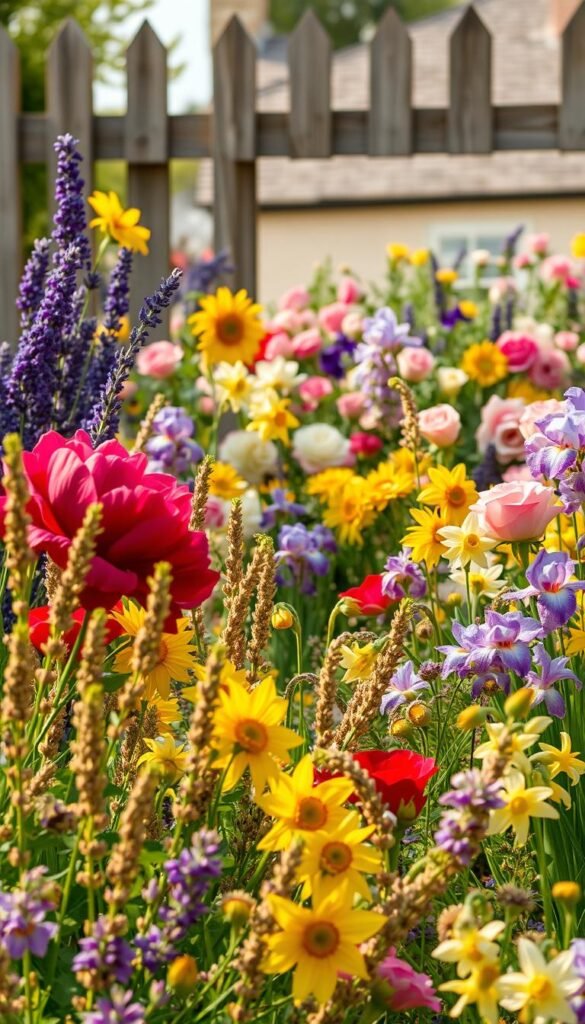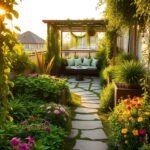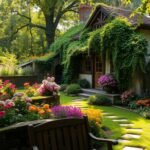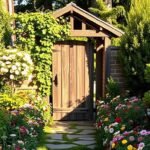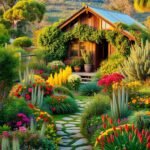Step into a world where vibrant colors and natural charm blend effortlessly. Imagine an outdoor space filled with blooms that whisper stories of old-world romance while adapting to modern tastes. This style of planting, rooted in centuries-old traditions, turns ordinary yards into lively retreats bursting with character.
Originally, these plantings served practical purposes—think herbs and vegetables mixed with cheerful blossoms. Today, they’ve evolved into artistic displays that balance structure with wild beauty. You’ll find a mix of perennials, annuals, and shrubs working together to create layers of texture and interest.
In this guide, you’ll discover time-tested favorites and fresh ideas to design your own slice of paradise. Whether you’re new to gardening or looking to refresh your landscape, we’ll walk through plant choices that thrive in diverse conditions. Learn how to combine colors, heights, and bloom times for year-round appeal.
Ready to transform your space? Let’s explore how simple tweaks—like adding climbing vines or clusters of daisy-like blooms—can turn even a small corner into a welcoming oasis. By the end, you’ll have the tools to craft a scene that feels both nostalgic and uniquely yours.
Introduction to Cottage Garden Charm
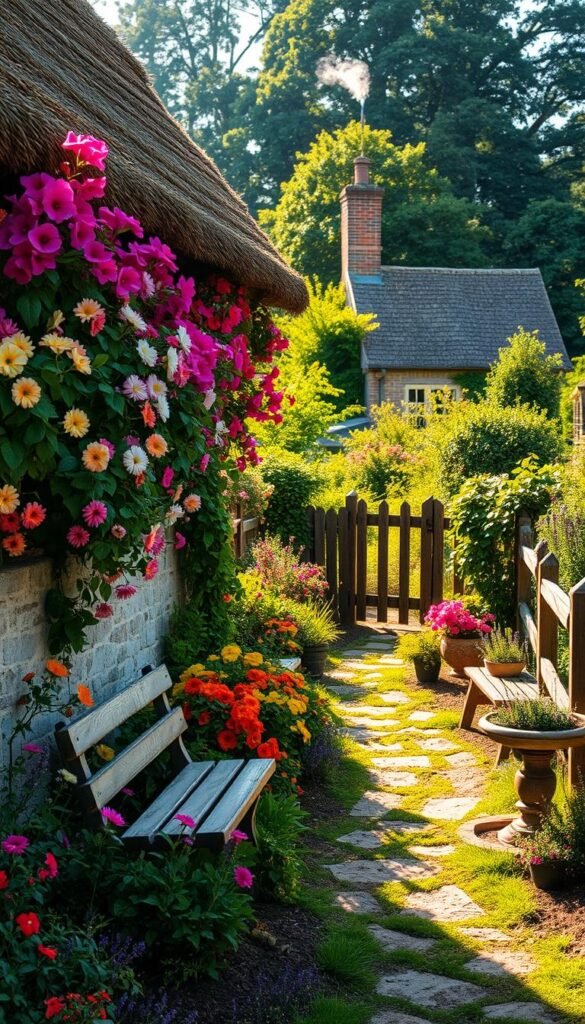
The story of these enchanting spaces starts not with aesthetics, but survival. What began as practical plots for rural families evolved into today’s beloved country landscapes bursting with life. Let’s uncover how humble roots grew into a design style that captivates gardeners worldwide.
The History Behind Cottage Gardens
In 15th-century England, working-class households cultivated small plots packed with vegetables, herbs, and fruit trees. Flowers like roses and hollyhocks edged paths, serving dual roles—beautifying spaces while repelling pests. Every plant earned its place through utility or hardiness.
By the 19th century, these spaces became symbols of romanticism. Climbing vines softened stone walls, while lavender and daisies spilled over walkways. The mix of edible and ornamental plants created self-sustaining ecosystems, a practice modern enthusiasts still admire.
Modern Interpretations of a Timeless Style
Today’s versions honor tradition while embracing flexibility. Designers might pair heirloom roses with drought-tolerant salvias or swap wooden fences for sleek metal trellises. The goal? Keep the wild, layered look while reducing maintenance.
| Feature | Traditional | Modern |
|---|---|---|
| Plant Purpose | Food & medicine first | Visual impact & ecology |
| Layout | Dense, irregular clusters | Strategic grouping |
| Structures | Weathered wood arbors | Mixed materials |
Want to blend old and new? Learn how to start your own with clever updates. Use native plants instead of fussy exotics, or add solar lighting to vintage-style lanterns. The magic lies in balancing nostalgia with today’s needs.
Understanding Cottage Garden Essentials
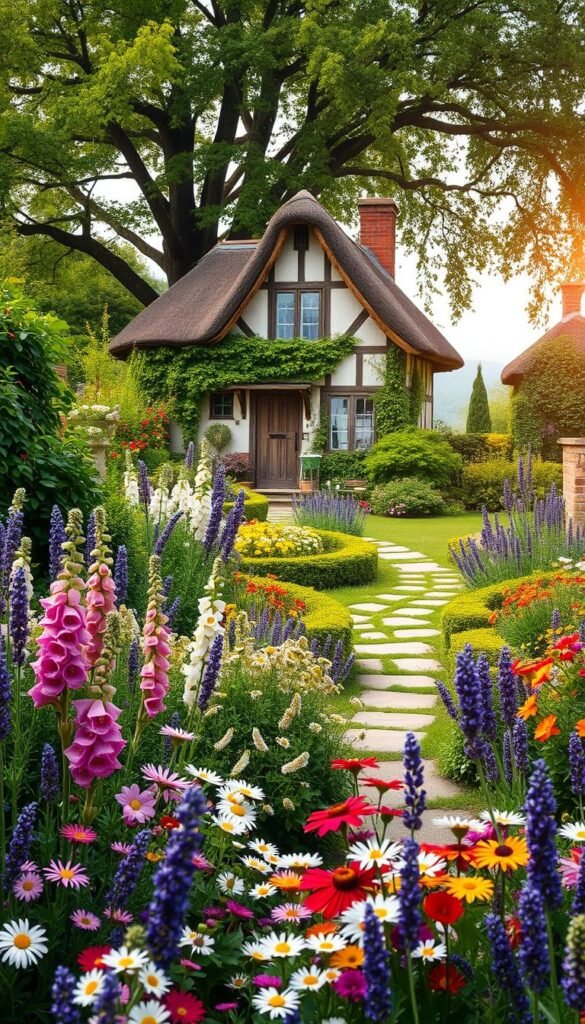
Picture your outdoor space as a living tapestry where every plant plays a role in nature’s theater. The magic of this design approach lies in its artful imperfection—think overflowing beds where blooms jostle for sunlight and scented leaves brush against your ankles.
Nature’s Recipe for Effortless Beauty
Forget straight lines and perfect symmetry. Here, controlled wildness reigns supreme. Start by layering plants like a painter blends colors—tall spires of foxgloves behind mounding catmint, with creeping thyme spilling over stepping stones. This creates depth while hiding bare soil.
Fragrance acts as your invisible design partner. Place aromatic herbs like rosemary near seating areas, and let evening-scented nicotiana perfume twilight strolls. These sensory touches transform spaces into multi-dimensional experiences.
| Design Principle | Practical Application |
|---|---|
| Layered Heights | Place 6′ hollyhocks behind 3′ phlox |
| Seasonal Rotation | Swap spring bulbs for summer cosmos |
| Self-Sowing Stars | Allow poppies & forget-me-nots to spread |
Self-seeding varieties become your garden’s storytellers. When calendula pops up between paving stones or columbine appears in unexpected corners, it adds that “always been here” charm. Just guide enthusiastic spreaders by thinning seedlings where needed.
Balance comes through subtle structure. Use low boxwood hedges to frame flower riots, or train clematis over arched gateways. These anchors prevent the look from becoming messy while letting plants shine in their joyful disorder.
Selecting the Perfect Full Sun and Shade Flowers
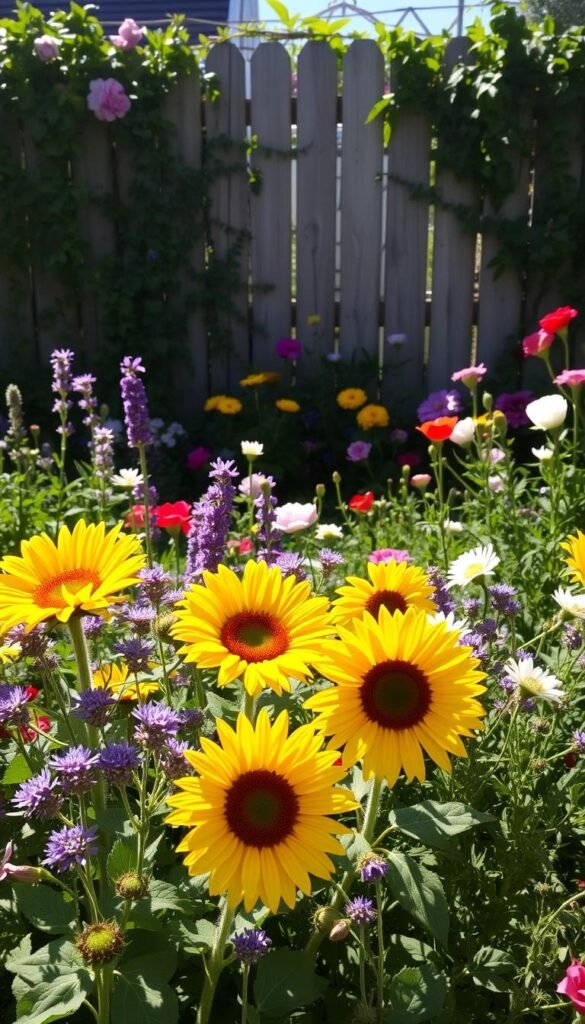
Ever notice how sunlight dances across your yard? That’s your secret map for choosing blooms that thrive in bright beams or filtered shade. Getting this balance right means every corner of your space can burst with life.
Start by tracking light patterns. Spend a day noting where shadows fall—morning sun differs from afternoon intensity. Areas with 6+ hours of direct light suit sun-worshippers like lavender and black-eyed Susans. For spots with dappled shade, coral bells add texture with their vibrant leaves.
Tips for Balancing Light and Shadow
Pair plants with matching needs. Group thirstier varieties in sunny zones where water evaporates faster. In shadowy areas, focus on moisture-loving species that avoid scorching. Remember: even shade-tolerant plants need 3-4 hours of filtered light.
“Think of your garden as a sundial. Watch it through the seasons—trees leaf out, structures cast new shadows. Adapt your planting zones accordingly.”
| Sun-Loving Stars | Shade Champions |
|---|---|
| Roses (6-8 hours) | Coral Bells (3-4 hours) |
| Russian Sage | Bleeding Heart |
| Coreopsis | Astilbe |
Struggling with tricky spots? Maximize every inch by training climbers like clematis on vertical structures. They’ll reach for sunlight while creating cool microclimates below. Mix heights and bloom times for nonstop color—tall sunflowers backdropping shade-tolerant ferns create depth without competition.
Creating a Layered and Romantic Garden Display
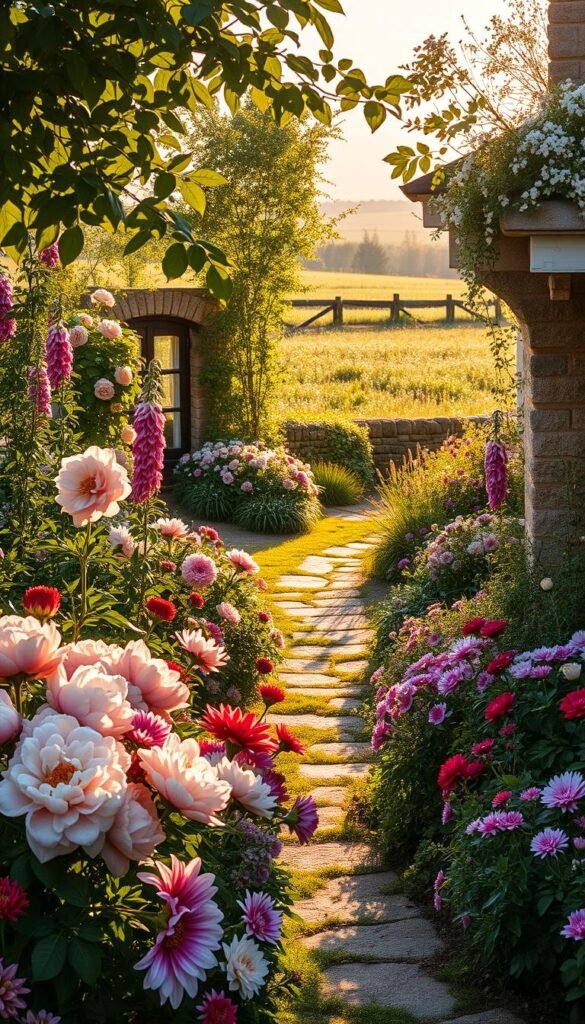
Imagine your outdoor space as a living painting where textures and heights dance together. Strategic layering turns flat beds into dimensional wonderlands. Start by placing tall bloomers like delphiniums at the back, mid-height peonies in the middle, and creeping thyme along edges.
Incorporating Borders, Arbors, and Trellises
Borders act like nature’s picture frames. Use low hedges or flowering shrubs to outline paths, creating natural walkways that invite exploration. For vertical drama, install DIY trellises behind seating areas. They’ll support climbing roses while making intimate nooks.
Rustic structures add instant character. Weathered wooden arbors draped with clematis create archways of color. Pair them with stone-edged beds for contrast—rough textures make blooms pop while echoing traditional designs.
Mix climbers with supportive perennials. Train sweet peas up obelisks surrounded by lavender. The purple spikes will hide leggy stems below while filling the air with scent. This combo delivers color from ground to eye level.
Remember: romance lives in details. Add a vintage bench under an arbor or let morning glories tumble over old bricks. These touches transform functional elements into storybook moments that captivate the senses.
Cottage Garden Flowers: Top 10 Varieties for a Flourishing Display
Curious which blooms turn ordinary spaces into storybook settings? Meet ten reliable performers that bring structure and spontaneity to your landscape. These selections thrive in mixed plantings while offering staggered bloom times for continuous color.
Exploring Each Star Variety in Detail
Bee balm shines with spiky red blooms that hummingbirds adore. Pair it with black-eyed Susans for a fiery summer show. Butterfly bush acts as a pollinator magnet, its purple spikes rising above silvery foliage.
Catmint offers months of lavender-blue flowers and aromatic leaves. Coneflowers stand drought-tolerant guard with daisy-like faces, while coral bells provide leaf color even when not blooming. Daylilies deliver daily surprises with fleeting blossoms that multiply yearly.
| Plant | Height | Bloom Time | Best For |
|---|---|---|---|
| Lavender | 2-3 ft | Early Summer | Borders & Fragrance |
| Roses | 4-8 ft | Spring-Fall | Vertical Interest |
| Sweet Peas | 6-8 ft | Spring | Trellises & Scent |
| Coral Bells | 1-2 ft | Spring-Summer | Shade Accents |
Classic choices like lavender and roses anchor designs with structure. Modern hybrids offer repeat blooming without constant care. Sweet peas bring old-world charm, their pastel blossoms perfuming spring air as they climb obelisks.
For lasting impact, interplant early bloomers with late-season stars. Place sun-loving varieties where they’ll get 6+ hours of light, and tuck shade-tolerant picks under arbors. Most thrive in well-drained soil with moderate water once established.
Mixing Perennials with Annuals for Continuous Blooms
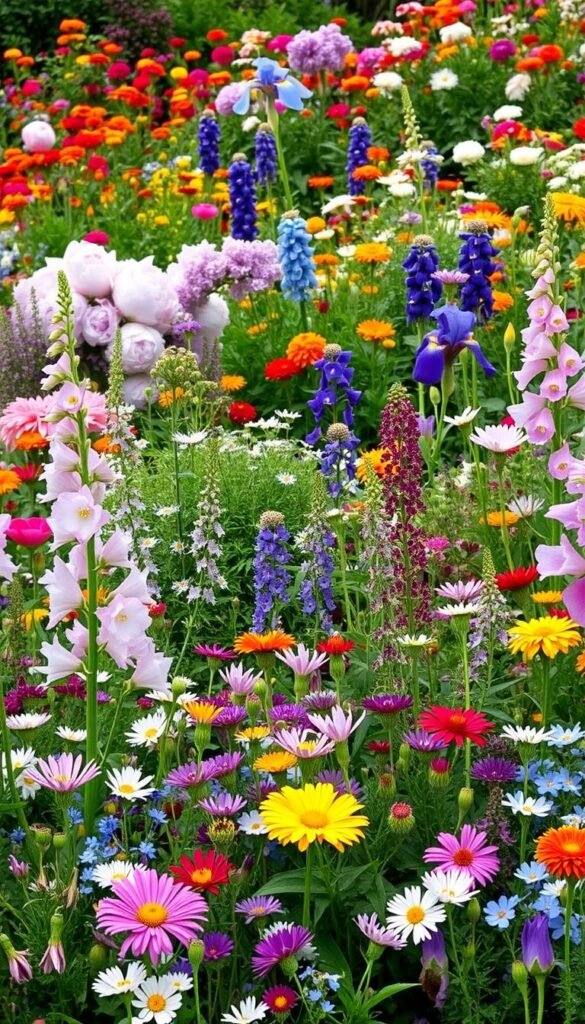
Think of your outdoor space as a living calendar where each plant marks the passage of time. By blending perennials and annuals, you create a rhythm that keeps beds lively from spring frost to autumn’s first chill. This dynamic duo works like clockwork—one group provides steadfast structure while the other delivers surprise pops of color.
Benefits of Long-Lived Perennials
Seasoned gardener Jenny Simpson calls perennials “the backbone of any great display.” Plants like daylilies return yearly, growing more robust with each season. Their deep roots help stabilize soil, while their recurring presence saves you replanting work.
Try pairing early bloomers like peonies with late-show stars like asters. This creates a relay race of color where one plant hands off to the next. Over time, these low-maintenance champions form clumps you can divide to expand your display.
The Spark of Annual Color
Annuals are your secret weapon against bare spots. Species like zinnias and phlox explode with blooms that last months, filling gaps between perennial showstoppers. Their quick growth lets you experiment with bold hues without long-term commitment.
For maximum impact, tuck heat-loving annuals around established perennials. Marigolds brighten rose beds in summer, while pansies add winter cheer to dormant areas. This approach keeps your space looking intentional yet effortless.
| Perennials | Annuals |
|---|---|
| 3+ year lifespan | Single-season performers |
| Invest time upfront | Instant gratification |
| Divide & expand | Reseed & refresh |
Designing with Fragrance and Color in Mind
Your landscape becomes a living canvas when scent and hue work in harmony. While vibrant petals catch the eye, aromatic leaves and blossoms create memories that linger long after you’ve stepped indoors. This dual approach transforms spaces into multi-sensory retreats.
Choosing Complementary Color Schemes
Traditional designs often whisper with soft blues, pinks, and lavenders. These gentle shades evoke nostalgia, like a faded quilt draped over a porch swing. For modern flair, pair silver foliage with crisp white flowers—a moonlit glow that brightens twilight hours.
Bold enthusiasts might paint with fiery reds and oranges. Imagine golden marigolds dancing beside purple salvias—a sunset captured in petals. Chartreuse leaves add zing between magenta poppies, proving contrast sparks joy.
| Classic Palette | Daring Mix |
|---|---|
| Pale pink roses | Orange cosmos |
| Powder blue delphiniums | Magenta zinnias |
| White daisies | Yellow coreopsis |
Weave fragrance into high-traffic areas. Plant lavender near benches where its scent rises as you sit. Train sweet peas along walkways—their perfume rewards every stroll. Evening-blooming nicotiana near windows turns night breezes into natural air fresheners.
Remember: plants with aromatic foliage like lemon thyme double as ground cover. Crush a leaf between fingers, and suddenly weeding becomes aromatherapy. Balance showy blooms with these subtle sensory touches for depth that delights all year.
Maximizing Bloom Time Throughout the Seasons
Transform your landscape into a year-round spectacle by orchestrating nature’s schedule. With smart plant selection and simple techniques, you’ll enjoy vibrant hues from the first crocus of spring to the last aster of fall.
Early Risers and Late Showstoppers
Start with sweet peas in early spring—their pastel blossoms climb trellises while frost still nips the air. Pair them with bleeding hearts, whose heart-shaped flowers thrive in cool weather. As temperatures rise, lavender takes over, offering fragrant spikes from spring through fall.
For late summer drama, black-eyed Susans become living suns glowing in September heat. Coneflowers stand tall beside them, their daisy-like faces attracting butterflies until frost. These hardy performers need minimal care once established.
| Early Season | Mid Season | Late Season |
|---|---|---|
| Sweet Peas | Bee Balm | Black-Eyed Susan |
| Bleeding Heart | Lavender | Coneflower |
Extend bloom periods with these tricks:
- Deadhead spent flowers weekly
- Apply balanced fertilizer in early summer
- Water deeply during dry spells
Even in dormant seasons, ornamental grasses add texture. Their feathery plumes catch frost like nature’s jewelry, proving beauty exists beyond bloom time.
Attracting Pollinators with Purposeful Planting
Your outdoor space can become a bustling hub for nature’s hardest workers. By choosing the right blooms, you’ll create a vibrant ecosystem where bees, butterflies, and hummingbirds thrive while boosting your garden’s productivity.
Nature’s Favorite Landing Pads
Certain plants act like neon signs for winged visitors. Master gardener Stacy Ling notes, “Black-eyed Susans work as cheerful welcome mats—their flat centers let multiple pollinators feed at once.” These golden blooms keep nectar flowing from summer through fall.
For targeted attraction:
- Bee balm’s tubular blossoms draw bumblebees like magnets
- Butterfly bushes offer landing platforms for monarchs and swallowtails
- Penstemon’s slender spikes become hummingbird fueling stations
| Plant | Attracts | Bloom Time |
|---|---|---|
| Bee Balm | Bees & Hummingbirds | June-August |
| Butterfly Bush | Butterflies | July-Frost |
| Penstemon | Hummingbirds | May-July |
Plan for continuous blooms by mixing early risers like lupines with late-season asters. This ensures pollinators never leave hungry. Your efforts reward you with lively movement and healthier plants through improved pollination.
Pairing Cottage Garden Flowers with Charming Shrubs
Shrubs are the unsung heroes that give your flower beds both shape and substance. These woody plants create living architecture, supporting delicate blooms while adding year-round structure. When chosen wisely, they become natural backdrops that make colors pop and fragrances linger.
Accenting with Hydrangeas and Roses
Hydrangeas act as seasonal chameleons. Their mophead blooms shift from creamy white to deep pink based on soil pH, offering months of visual interest. Plant them near entryways where their generous flowers whisper nostalgia. For contrast, pair with airy grasses that sway in the breeze.
No landscape feels complete without roses. Climbing varieties transform plain walls into vertical tapestries, while shrub types mingle beautifully with perennials. Try training ‘New Dawn’ roses over an arbor—their soft pink blossoms will frame your view like living curtains.
| Shrub | Height | Spacing Tip |
|---|---|---|
| Hydrangea | 4-6 ft | Allow 3 ft from paths |
| Butterfly Bush | 5-8 ft | Plant behind lower growers |
| Roses | 3-10 ft | Keep 2 ft between stems |
Butterfly bush serves double duty. Its tapered purple spikes attract pollinators while hiding leggy perennials behind it. For layered depth, place taller shrubs at the rear of borders and compact varieties like boxwood near edges.
Remember: balance is key. Let hydrangeas anchor corners while roses climb freely. This mix creates rhythm without rigidity, letting each plant shine in its role. Your space will feel both grounded and delightfully wild.
Styling Your Garden with Vintage an
Your outdoor haven becomes a living scrapbook when infused with nostalgic touches. Hunt for weathered troughs or chipped teacups to repurpose as planters—herbs like thyme thrive in these quirky homes. An iron bench draped with lichen tells stories, while a rusty lantern filled with trailing petunias adds whimsy.
Mix materials for visual intrigue. Pair smooth river stones with rough-hewn wooden signs near clusters of lavender. For practical container strategies that blend charm and function, explore patio gardening solutions using salvaged items. This approach turns everyday objects into conversation starters.
Let your space evolve like a favorite novel. A cracked birdbath might host succulents one year and coleus the next. These imperfections create authenticity, proving beauty thrives in adaptation. Start small—one vintage treasure can spark a cascade of inspired design choices.

